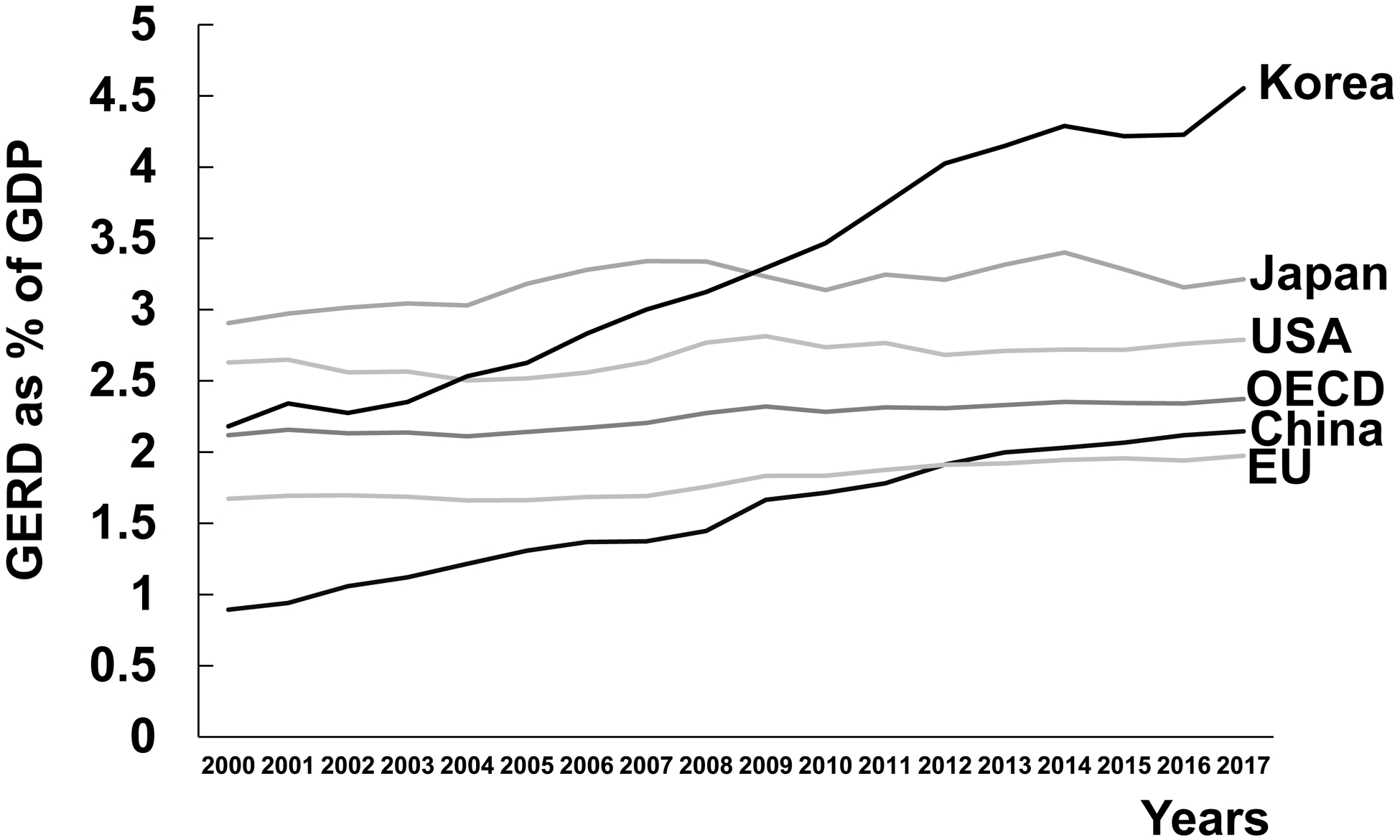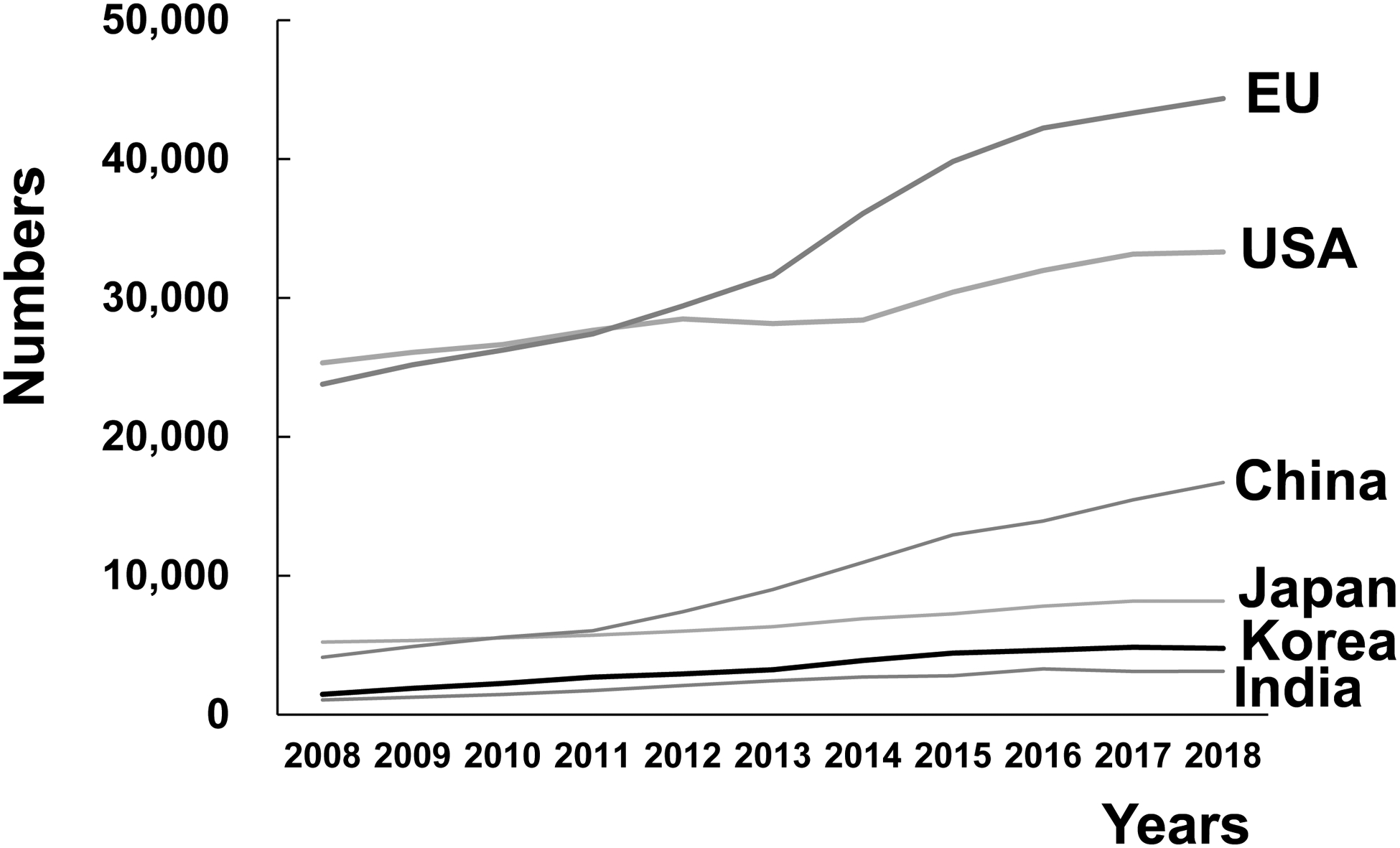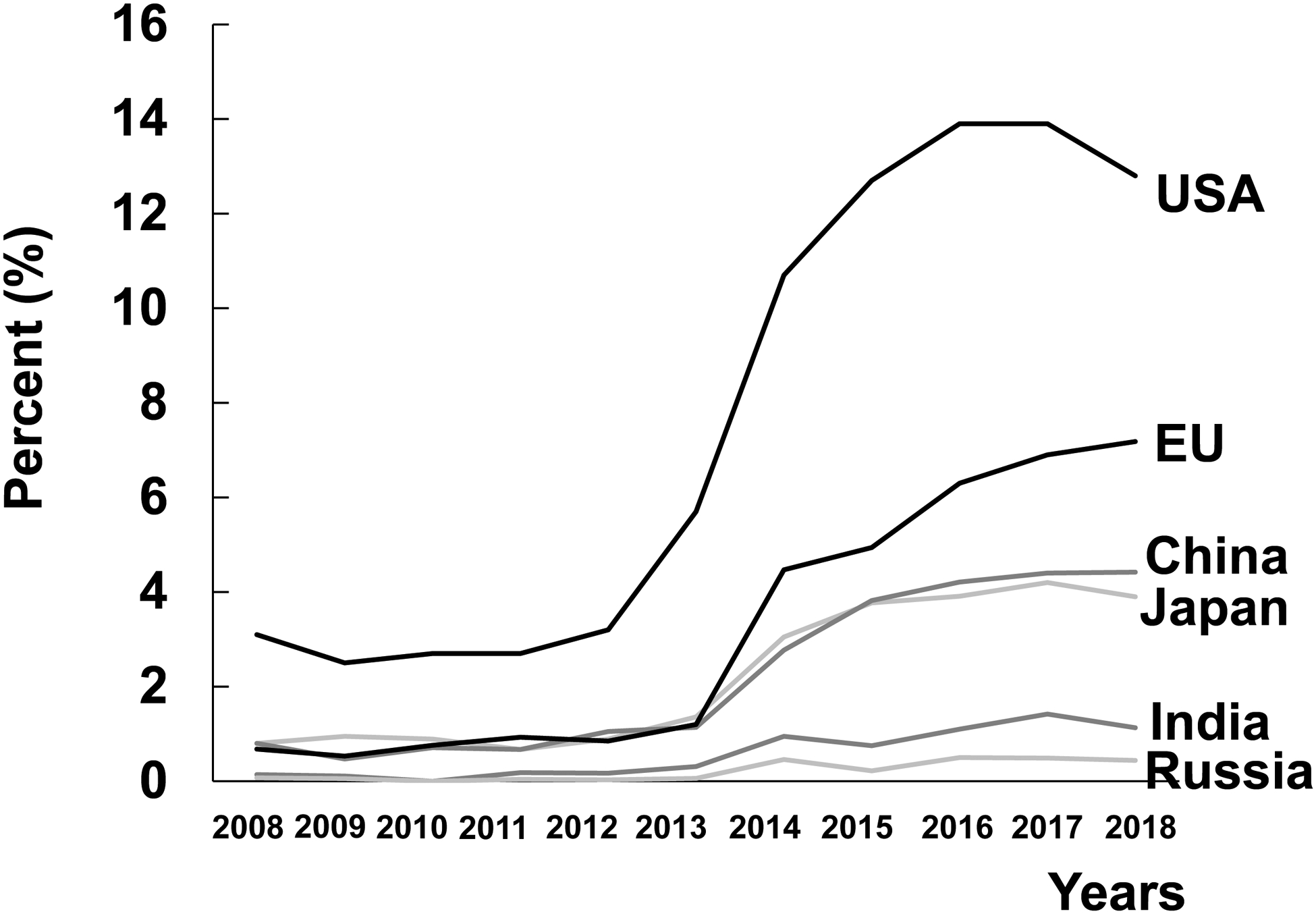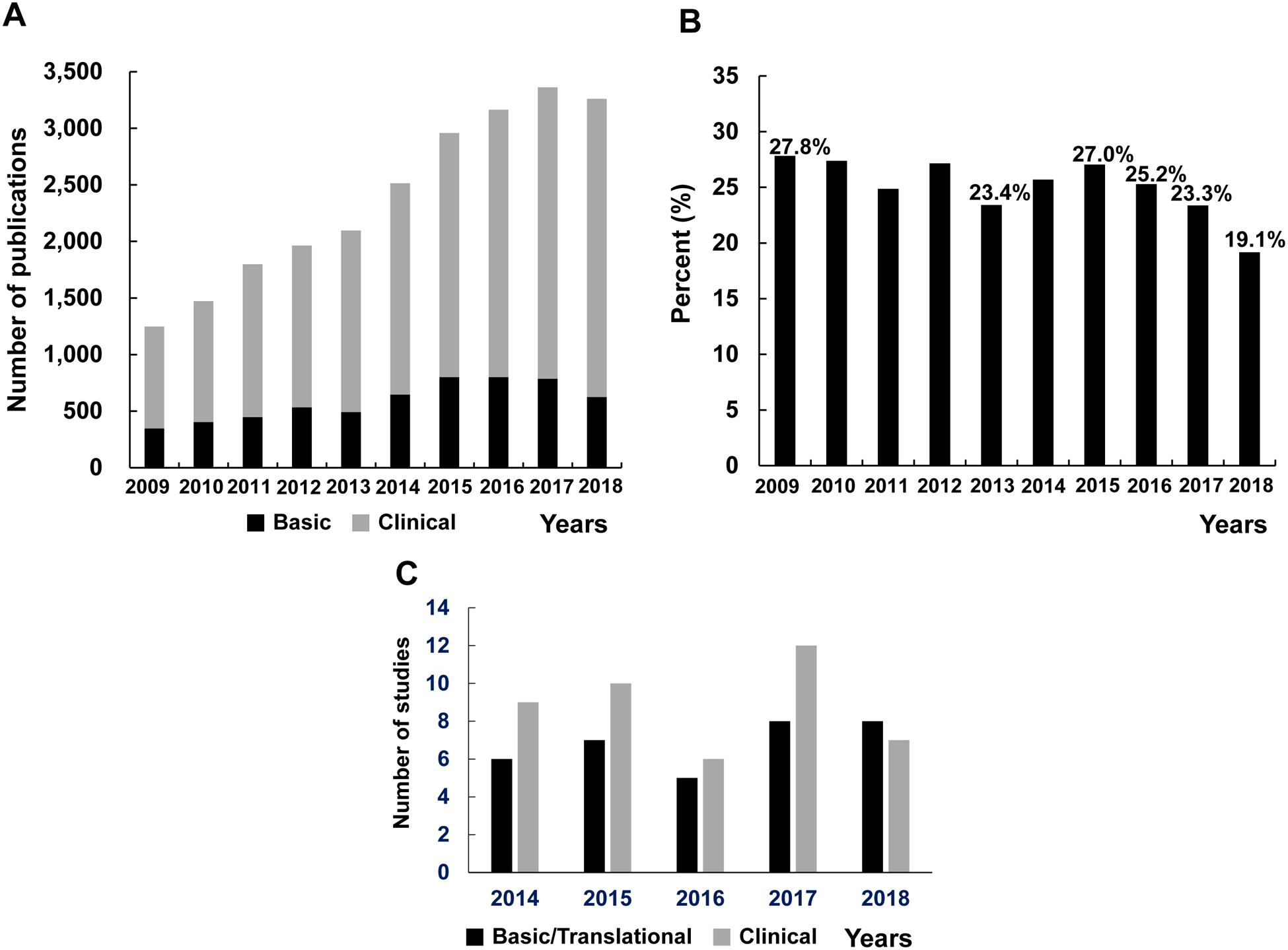Abstract
Cardiovascular diseases have shown a continuous increase in Korea over the past decade, and became the second most common cause of mortality in Korea. Although the number and the amount of total grants for cardiovascular research have increased in Korea, the proportion of the number of grants and total amount allocated for the cardiac/cardiovascular field to all health and medical research fields has not changed much over this period. In addition, the publications related to clinical research have substantially increased in Korea along with the number of nation-wide registries for cardiovascular diseases, but basic and translational research did not show significant growth, requiring new measures to promote basic and translational cardiovascular research in Korea.
Keywords: cardiovascular diseases, basic research, grants, publications, Korea
Epidemiology of Cardiovascular Diseases in Korea
Over the past 10 years, there has been an increase in chronic diseases in Korea1, with a notable rise in cardiovascular diseases (CVDs). CVDs accounted for 840,678 deaths in the United States of America (USA) in 2016, approximately 1 of every 3 deaths2 and caused 3.9 million deaths in Europe, accounting for 45% of all deaths3. Similar to the USA and European countries, CVDs have become one of the leading causes of morbidity and mortality in Korea and have imposed a high economic healthcare burden1. Of the total deaths reported in 2016, 28.4% were caused by neoplasms and 21.5% by diseases of the circulatory system (heart diseases 12.8% and cerebrovascular diseases 8.3%)4. Although the mortality from CVDs in Korea is less than in the USA and European countries, it has been predicted that the socioeconomic burden of these diseases will increase because of the prolonged duration of disease and accompanying disabilities5, 6. Disease burden based on the years of life lost (YLLs) per 100,000 population for circulatory system diseases was 2,679 in the USA7 and 824 in Korea8. When assessed as Disability-Adjusted Life Years (DALYs), the burden of circulatory system diseases was much greater than that of neoplasms (3,226 vs. 2,261 DALYs, per 100,000 population) in Korea8, but similar in the USA (3,065 for circulatory system vs. 3,131 DALYs for neoplasms, per 100,000 population)7. In Korea, YLLs decreased 6.5% for ischemic heart disease (IHD) and 28.8% for ischemic stroke from 2007 to 20159. However, DALYs increased 40.8% for IHD and 39.3% for ischemic stroke during the same period, suggesting a steady increase of overall CVD burden in Korea. In Europe, DALYs due to CVDs decreased in most European countries over the last decade3.
The Korean Heart Study group developed a coronary heart disease prediction model and found that the Korean population has a lower risk of IHD, but a higher risk of stroke as compared to Western populations, when they have the same risk factors10. The most common attributable risk factor was hypertension. Smoking and dyslipidemia were more strongly associated with IHD and hypertension was more strongly associated with stroke10. To address this issue, researchers recalibrated the Framingham Risk Equation using the Asian cohort data11 and developed risk prediction models for stroke12, 13, IHD10, and atherosclerotic CVD14 using Korean cohort data.
Cardiovascular Societies and Related Journals
As in the USA and European countries, various academic societies and organizations have been established in the cardiovascular field in Korea following the increase in CVDs and the resultant growth of clinical and research professionals in Korea. These societies regularly conduct professional academic meetings, public educational and promotional events, and publish peer-reviewed professional journals. The Korean Society of Cardiology (https://www.circulation.or.kr:4443/eng/) is the largest cardiovascular society with more than 1,600 members. It was founded in 1957, and has hosted cardiology conferences, symposiums, and various professional and public programs, and has published a professional peer-reviewed journal called “Korean Circulation Journal” since 1971. Other societies include the Korean Society of Lipid and Atherosclerosis (1990; http://www.lipid.or.kr/eng/; publishing “Journal of Lipid and Atherosclerosis”), Korean Society of Echocardiography (1993; http://www.ksecho.org/eng/; publishing “Journal of Cardiovascular Ultrasound”), Korean Society of Hypertension (1994; http://www.koreanhypertension.org/eng; publishing “Clinical Hypertension”), Korean Heart Rhythm Society (1997; http://en.e-arrhythmia.org/; publishing “International Journal of Arrhythmia”), Korean Society of Interventional Cardiology (1997; http://www.kscvi.org/new_ksic2015_en/), Korean Pediatric Heart Society (2001; http://www.pediheart.or.kr/), Korean Vascular Science and Medicine Organization (2004), Korean Society of Cardiovascular Disease Prevention (2010; http://koreascp.or.kr/), and Korean Society of Heart Failure (2018; http://khfs.or.kr/eng/).
Funding for Cardiovascular Research in Korea
In Korea, two government organizations support cardiovascular research: the Ministry of Health and Welfare (MoHW) and the Ministry of Science, Information and Communications Technology (MSIT). The MoHW provides research funding through various affiliated institutions, among which the Korea Health Industry Development Institute (KHIDI) and Korea Centers for Disease Control & Prevention (KCDC) are the main sponsors of cardiovascular research. The MSIT supports basic and translational research through the National Research Foundation (NRF). The NRF of Korea (http://www.nrf.re.kr/eng/main) was founded in 2009, aiming to optimize and advance the national basic research funding system. Other sources of grants are available through various cardiovascular societies and study groups within societies. Some grants are available from private foundations and pharmaceutical or device companies that support basic research and clinical trials. While many clinical trials are supported by commercial grants, the total figures are unknown.
According to the Organisation for Economic Co-operation and Development (OECD) data, the expenditure on Research and Development (R&D) for OECD and several other countries showed that Korea and China have had the most significant increase in R&D budgets between 2000 and 2017 as compared to the USA and other countries in the European Union (EU) or the OECD. R&D intensity (expenditure on R&D as a percentage of Gross Domestic Product, GDP) in Korea rose rapidly from 2.18% in 2000 to 4.55% in 2017 (Figure 1A)15. The 2017 R&D budget of the NRF in Korea showed that the total amount was 4,316 million US dollars, of which 865 million dollars (20%) were assigned to basic research, 566 million dollars (13%) to academic research capacity enhancement, 468 million dollars (11%) to promotion and groundwork for research, and 41 million dollars (1%) to international collaboration. In the past decade, the number and amount of grants for health and medical fields among the grants for all fields of research supported by the Korean government has increased from 9.8% in 2009 to 13.8% in 2016 and from 7.8% in 2009 to 9.5% in 2016. However, there has been no overt change in the relative number of grants for cardiovascular research among the total grants in the medical fields during this time, from 7.4% in 2009 to 7.9% in 2016, despite the increasing incidence of CVDs and the overall mortality associated with CVDs in Korea. Such discrepancy may require further assessment and consideration for redistribution of the budget according to the significance of the disease.
Figure 1.



Research and development (R&D) intensity, the number of publications and research collaborations on cardiovascular topics by countries. A Gross expenditure on research and development (GERD) as a percentage of the gross domestic product (GDP) by countries from 2000 to 2017. B The number of publications by Korea and other countries on cardiovascular topics published from January 2008 to December 2019. C The percentage of the number of publications by collaborations between Korea and other countries out of the number of total publications on cardiovascular topics by Korean investigators.
In the USA, two major funders for biomedical research are the National Institutes of Health (NIH) and the medical product industries. The USA also has experienced a gap in the funding for CVDs by a large margin compared to cancer and immunology16. The National Heart, Lung and Blood Institute in the NIH has experienced relative stagnation in funding, from $1.95 billion in 2014 to $2.3 billion in 201816. In the EU nations, €876 million were awarded for CVD research over a 3-year period (2010–12). A total of 130 organizations funded CVD research; government and public funding account for about 53% of total grants, and charities and private agencies provide the other 47%17.
Publications
The number of publications related to cardiovascular research has grown in accordance with increasing funding. Figure 1B shows the number of publications on cardiovascular topics by countries over the past decade. Overall, the total number of publications from Korea, Japan, India and the USA in the cardiovascular field has gradually increased with the most notable increase seen from the EU and China. The number of studies registered in clinicaltrials.gov from Korea as of April 2019 was 1,402, which are lower than most other OECD countries: USA (12,686), Germany (3,119), France (2,740), United Kingdom (2,384), China (2,025), and Japan (811). International collaboration between Korea and other countries for cardiovascular research has suddenly increased since 2013 based upon the number of publications. The most frequent collaborations were made with the USA, followed by the EU, China, Japan, India and Russia (Figure 1C). This increase appears to result from the governmental efforts to promote international collaboration, which include set-aside funding for international collaborative research, promoting global networks, and establishment of international joint research guidelines.
Overall, the total number of publications in both basic and clinical cardiovascular research has substantially increased over the past decade in Korea (Figure 2A). The proportion of publications in basic cardiovascular research among all publications in the cardiovascular field did not change between 2009 and 2015 (23.4%−27.8%); however, it has gradually decreased from 2015 (27.0%) to 2018 (19.1%) (Figure 2B). Moreover, the number of publications in high profile journals (impact factor > 10) has not significantly changed in the past five years, averaging less than 20 per year (Figure 2C). The statistics were derived by a PubMed search, and only those studies performed by the corresponding investigator with an appointment in a Korean institution were counted. In the high-impact category, the number of publications resulting from clinical trials is still slightly higher than basic and translational research. Considering the amount and the number of grants supporting basic and translational research, the impact of basic and translational research has room for improvement. Clinical trial studies have stronger outputs compared to the overall funding amount.
Figure 2.

Publications of the cardiovascular field from Korea through a PubMed search. A The number of publications in the cardiovascular field for basic research (black color) and clinical research (gray color) from 2009 to 2018. B The proportion of the number of basic research publications (both in vitro and animal studies) among total publications (basic and clinical research) in the cardiovascular field from 2009 to 2018. C The number of publications in the high impact factor (IF > 10) journals in the cardiovascular field in basic and translational research (black color) and clinical research (gray color) published by corresponding investigators belonging to a Korean institution.
Unique opportunities of research in Korea
The National Health Insurance Service–National Sample Cohort (NHIS-NSC) is a population-based cohort established by the National Health Insurance Service (NHIS) in Korea18. The main aim of organizing this big cohort group was to provide the representative and useful information on Korean people’s health to the researchers of public health and policy makers18. The NHIS-NSC was firstly constructed with a population of 46,605,433 individuals in 2002 and then a representative sample cohort of 1,025,340 (2.2% of the total) was randomly selected and followed for 11 years18. Over years, the number of large population-based epidemiologic studies using the NHIS Research Databases have steadily increased19, 20. Despite their usefulness, the Korean NHIS-NSC database has several limitations such as insufficient information for rare diseases, some uncertainty of disease codes, and inherent limitations of insurance databases18. Therefore, a cautious use of the database and interpretation are necessary.
Summary and Future Perspectives
CVDs have shown a continuous increase in Korea over the past decade, and are the second most common cause of mortality in Korea. Therefore, the number and the amount of total grants for cardiovascular research have increased, along with the number of nation-wide registries and publications associated with cardiovascular research. Although the overall funding has increased, the proportion of the number of grants and total amount allocated for the cardiac/cardiovascular field to all health and medical research fields has not changed much over this period. Owing to the increased number of physicians and hospitals and the availability of National Health Insurance Data, the publications related to clinical research have substantially increased; however, basic and translational research did not show significant growth. New measures may be necessary to promote basic and translational cardiovascular research in terms of personnel, resources, and funding in Korea.
Sources of funding
This work was supported by grants from the Bio & Medical Technology Development Program of the National Research Foundation (NRF) funded by the Korean government (MSIP) (No 2015M3A9C6031514), the Korea Health Technology R&D Project through the Korea Health Industry Development Institute (KHIDI) funded by the Ministry of Health & Welfare (HI15C2782, HI16C2211), and Ministry of Food and Drug Safety in 2018 (18172MFDS182), and grants from NIDDK (DP3-DK108245) and NHLBI (R01HL127759, R01HL129511).
Footnotes
Disclosures
None.
References
- 1.Yoon J, Seo H, Oh IH, Yoon SJ. The non-communicable disease burden in korea: Findings from the 2012 korean burden of disease study. J Korean Med Sci. 2016;31 Suppl 2:S158–S167. [DOI] [PMC free article] [PubMed] [Google Scholar]
- 2.Benjamin EJ, Muntner P, Alonso A, Bittencourt MS, Callaway CW, Carson AP, Chamberlain AM, Chang AR, Cheng S, Das SR, et al. Heart disease and stroke statistics-2019 update: A report from the american heart association. Circulation. 2019;139:e56–e528. [DOI] [PubMed] [Google Scholar]
- 3.Timmis A, Townsend N, Gale C, Grobbee R, Maniadakis N, Flather M, Wilkins E, Wright L, Vos R, Bax J, et al. European society of cardiology: Cardiovascular disease statistics 2017. Eur Heart J. 2018;39:508–579. [DOI] [PubMed] [Google Scholar]
- 4.Korea national statistical office. Cause of death statistics from statistics korea. 2018. [Google Scholar]
- 5.Lee SW, Kim HC, Lee HS, Suh I. Thirty-year trends in mortality from cardiovascular diseases in korea. Korean Circ J. 2015;45:202–209. [DOI] [PMC free article] [PubMed] [Google Scholar]
- 6.Lee SW, Kim HC, Lee HS, Suh I. Thirty-year trends in mortality from cerebrovascular diseases in korea. Korean Circ J. 2016;46:507–514. [DOI] [PMC free article] [PubMed] [Google Scholar]
- 7.Kaiser family foundation analysis of data from institute for health metrics and evaluation. Global burden of disease study 2015. 2015. [Google Scholar]
- 8.Yoon J, Oh IH, Seo H, Kim EJ, Gong YH, Ock M, Lim D, Lee WK, Lee YR, Kim D, et al. Disability-adjusted life years for 313 diseases and injuries: The 2012 korean burden of disease study. J Korean Med Sci. 2016;31 Suppl 2:S146–S157. [DOI] [PMC free article] [PubMed] [Google Scholar]
- 9.Kim YE, Park H, Jo MW, Oh IH, Go DS, Jung J, Yoon SJ. Trends and patterns of burden of disease and injuries in korea using disability-adjusted life years. J Korean Med Sci. 2019;34:e75. [DOI] [PMC free article] [PubMed] [Google Scholar]
- 10.Jee SH, Jang Y, Oh DJ, Oh BH, Lee SH, Park SW, Seung KB, Mok Y, Jung KJ, Kimm H, et al. A coronary heart disease prediction model: The korean heart study. BMJ Open. 2014;4:e005025. [DOI] [PMC free article] [PubMed] [Google Scholar]
- 11.Asia Pacific Cohort Studies C, Barzi F, Patel A, Gu D, Sritara P, Lam TH, Rodgers A, Woodward M. Cardiovascular risk prediction tools for populations in asia. J Epidemiol Community Health. 2007;61:115–121. [DOI] [PMC free article] [PubMed] [Google Scholar]
- 12.Jee SH, Park JW, Lee SY, Nam BH, Ryu HG, Kim SY, Kim YN, Lee JK, Choi SM, Yun JE. Stroke risk prediction model: A risk profile from the korean study. Atherosclerosis. 2008;197:318–325. [DOI] [PubMed] [Google Scholar]
- 13.Jung KJ, Hwang S, Lee S, Kim HC, Jee SH. Traditional and genetic risk score and stroke risk prediction in korea. Korean Circ J. 2018;48:731–740. [DOI] [PMC free article] [PubMed] [Google Scholar]
- 14.Park GM, Han S, Kim SH, Jo MW, Her SH, Lee JB, Lee MS, Kim HC, Ahn JM, Lee SW, et al. Model for assessing cardiovascular risk in a korean population. Circ Cardiovasc Qual Outcomes. 2014;7:944–951. [DOI] [PubMed] [Google Scholar]
- 15.Oecd, gross domestic spending on r&d (indicator). Doi: 10.1787/d8b068b4-en (accessed on 05 september 2019). OECD. 2019. [DOI] [Google Scholar]
- 16.Nicholls M. Funding of cardiovascular research in the USA: Robert califf and peter libby - speak about cardiovascular research funding in the united states and what the latest trends are with mark nicholls. Eur Heart J. 2018;39:3629–3631. [DOI] [PubMed] [Google Scholar]
- 17.Nicholls M. Funding cardiovascular research in europe. Eur Heart J. 2019;40:80–82. [DOI] [PubMed] [Google Scholar]
- 18.Lee J, Lee JS, Park SH, Shin SA, Kim K. Cohort profile: The national health insurance service-national sample cohort (nhis-nsc), south korea. Int J Epidemiol. 2017;46:e15. [DOI] [PubMed] [Google Scholar]
- 19.Shin DW, Cho B, Guallar E. Korean national health insurance database. JAMA Intern Med. 2016;176:138. [DOI] [PubMed] [Google Scholar]
- 20.Lee H, Cho J, Shin DW, Lee SP, Hwang SS, Oh J, Yang HK, Hwang SH, Son KY, Chun SH, et al. Association of cardiovascular health screening with mortality, clinical outcomes, and health care cost: A nationwide cohort study. Prev Med. 2015;70:19–25. [DOI] [PubMed] [Google Scholar]


